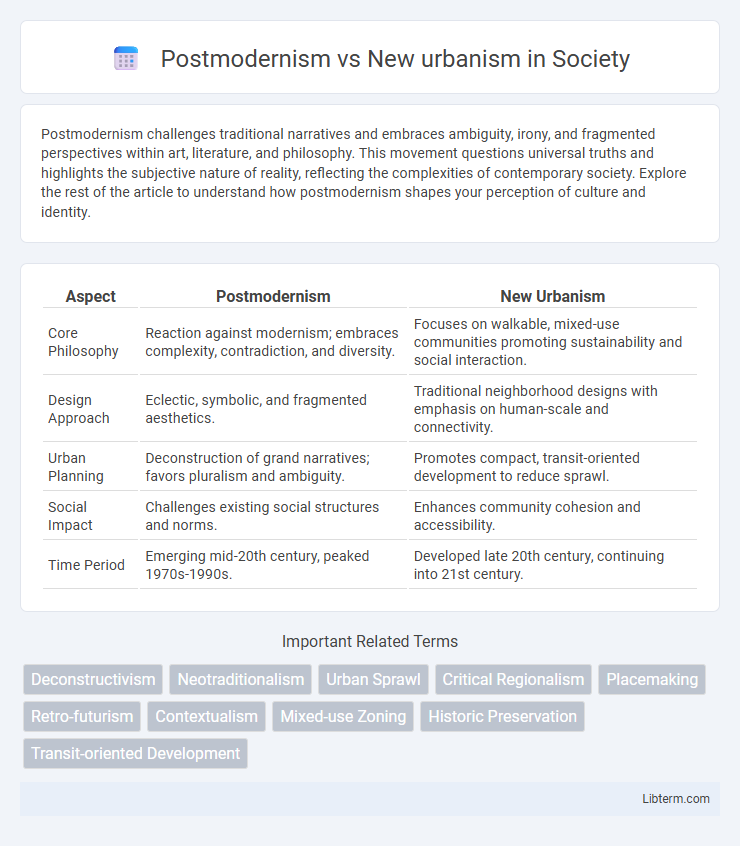Postmodernism challenges traditional narratives and embraces ambiguity, irony, and fragmented perspectives within art, literature, and philosophy. This movement questions universal truths and highlights the subjective nature of reality, reflecting the complexities of contemporary society. Explore the rest of the article to understand how postmodernism shapes your perception of culture and identity.
Table of Comparison
| Aspect | Postmodernism | New Urbanism |
|---|---|---|
| Core Philosophy | Reaction against modernism; embraces complexity, contradiction, and diversity. | Focuses on walkable, mixed-use communities promoting sustainability and social interaction. |
| Design Approach | Eclectic, symbolic, and fragmented aesthetics. | Traditional neighborhood designs with emphasis on human-scale and connectivity. |
| Urban Planning | Deconstruction of grand narratives; favors pluralism and ambiguity. | Promotes compact, transit-oriented development to reduce sprawl. |
| Social Impact | Challenges existing social structures and norms. | Enhances community cohesion and accessibility. |
| Time Period | Emerging mid-20th century, peaked 1970s-1990s. | Developed late 20th century, continuing into 21st century. |
Introduction to Postmodernism and New Urbanism
Postmodernism in architecture challenges the rigid functionalism of modernism by embracing eclecticism, ornamentation, and historic references to create spaces rich in meaning and cultural context. New Urbanism promotes sustainable, walkable communities by advocating traditional neighborhood design principles, mixed-use development, and human-scale urban planning to counter urban sprawl. Both movements respond to modernist shortcomings but diverge in focus--Postmodernism in aesthetic and symbolic complexity versus New Urbanism in urban form and social interaction.
Historical Context and Origins
Postmodernism emerged in the mid-20th century as a reaction against the functionalist and modernist architectural principles that dominated after World War II, emphasizing diversity, complexity, and historical reference. New Urbanism arose in the early 1980s, rooted in the critique of suburban sprawl and modernist planning, advocating for walkable neighborhoods, mixed-use development, and traditional town planning principles inspired by pre-automobile urban forms. Both movements respond to modernism's legacy but differ in their historical context, with Postmodernism focusing on architectural style and cultural pluralism, while New Urbanism centers on urban design and sustainable community development.
Core Principles of Postmodernism
Postmodernism in architecture emphasizes diversity, complexity, and contradiction, rejecting the rigid functionalism and minimalism of modernism. It incorporates historical references, ornamentation, and eclectic styles to create buildings that engage with cultural context and human experience. This contrasts with New Urbanism's focus on walkability, mixed-use development, and sustainable community design, which prioritize planning and urban form over aesthetic plurality.
Key Features of New Urbanism
New Urbanism emphasizes walkable neighborhoods, mixed-use development, and sustainable design, promoting community interaction and reducing car dependency. It integrates diverse housing types, prioritizes public transit access, and fosters environmental stewardship through green spaces and energy-efficient buildings. This approach contrasts with Postmodernism's eclectic architectural styles by focusing on urban planning principles that enhance livability and social cohesion.
Architectural Styles Compared
Postmodernism in architecture embraces eclecticism, ornamentation, and historical references, often blending various styles to create visually complex structures that challenge modernist simplicity. New Urbanism prioritizes sustainable, walkable communities with traditional neighborhood designs featuring mixed-use buildings, human-scale proportions, and emphasis on public spaces. While Postmodernism focuses on stylistic expression and architectural diversity, New Urbanism integrates urban planning principles aiming for functional, livable environments that reconnect architecture with community and environmental needs.
Urban Design Philosophies
Postmodernism in urban design emphasizes eclectic aesthetics, historic references, and diversity in form, rejecting the rigid functionalism of modernism. New Urbanism promotes walkable neighborhoods, mixed-use development, and sustainable community planning, prioritizing human scale and connectivity. Both philosophies influence urban environments but differ in their core values: postmodernism centers on stylistic plurality, while New Urbanism advances comprehensive environmental and social integration.
Social and Environmental Impacts
Postmodernism in urban design often results in fragmented social spaces that emphasize aesthetic diversity but can hinder community cohesion, whereas New Urbanism promotes walkable neighborhoods fostering social interaction and inclusivity. Environmentally, Postmodernist developments typically prioritize stylistic expression over sustainability, leading to higher energy consumption and carbon footprints, while New Urbanism emphasizes green infrastructure, reduced car dependency, and sustainable resource use, significantly lowering environmental impact. These contrasting approaches highlight Postmodernism's challenges in addressing social equity and ecological balance, which New Urbanism actively seeks to integrate through human-centered and environmentally conscious design principles.
Public Spaces: Contrasts and Similarities
Postmodernism in public spaces emphasizes eclectic design, symbolism, and historical references to create visually engaging environments that challenge modernist uniformity. New Urbanism prioritizes walkability, mixed-use spaces, and human-scale development to foster community interaction and sustainable urban living. Both approaches value public spaces as social catalysts but differ in stylistic expression and planning principles.
Criticisms and Controversies
Postmodernism in architecture faces criticism for its perceived lack of coherence and excessive ornamentation, often seen as superficial and historically inconsistent. New Urbanism, while praised for promoting walkability and community, is criticized for fostering gentrification and sometimes prioritizing aesthetics over affordability and diverse urban needs. Both movements spark debates over their impact on urban identity, social equity, and sustainable development.
Future Trends in Urban Development
Future trends in urban development highlight the divergence between Postmodernism's eclectic architectural styles and New Urbanism's emphasis on sustainable, walkable communities. New Urbanism prioritizes mixed-use neighborhoods, green spaces, and public transportation integration to combat urban sprawl and promote social connectivity. Postmodernism's influence persists in introducing diverse aesthetic expressions and historic references, yet New Urbanism's principles increasingly shape city planning to adapt to climate change and evolving social dynamics.
Postmodernism Infographic

 libterm.com
libterm.com